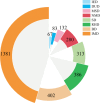Clinical experience of the expanded carrier screening for recessive genetic diseases in a large cohort study in Southern central China
- PMID: 40281011
- PMCID: PMC12032240
- DOI: 10.1038/s41598-025-99253-9
Clinical experience of the expanded carrier screening for recessive genetic diseases in a large cohort study in Southern central China
Abstract
Recessive monogenic disorders represent a significant cause of congenital malformations and disabilities in pediatric populations. The present study aims to provide the first comprehensive assessment of clinical experience with expanded carrier screening (ECS) panels in a large cohort from the Jiangxi province of Southern Central China. An ECS panel encompassing 147 genes associated with 155 genetic disorders was initially performed on 5,104 pre-gestational/prenatal females using next-generation sequencing. Following the identification of autosomal recessive conditions in female partners, sequential genetic testing was offered to 1,351 male partners, which included either the same ECS panel or other appropriate genetic tests. Comprehensive reproductive counseling was provided to all the identified at-risk couples (ARCs). Overall, 6,308 participants accepted ECS for 155 conditions (Female: 5,104, Male: 1,204) and approximately 38.43% (2,424/6,308) of them were detected as carriers for at least one of the 155 genetic conditions. The top four prevalent conditions identified in Jiangxi Province were α-thalassemia, GJB2-associated hearing loss, Krabbe disease and Wilson's disease. Among the participated cohort, 1,960 females were identified with AR variants and 1,351 male partners received sequential testing, at a recall rate of 68.93%. Among the tested couples, a total of 36 ARCs (36/1,357, 2.65%) were identified with the same AR (n = 27) or X-linked conditions (n = 9). Our study represents the first large-scale demonstration of the substantial feasibility of ECS in the Jiangxi population of Southern Central China. Based on our findings, we propose that incorporating genes with a carrier frequency threshold of 1/2,000 in the screening panel could serve as an optimal criterion. Our findings may contribute significantly to facilitating future clinical implementations of ECS.
Keywords: Expanded carrier screening; Recessive conditions, at-risk couples; Southern Central China.
© 2025. The Author(s).
Conflict of interest statement
Declarations. Competing interests: The authors declare no competing interests. Ethics approval and consent to participate: Ethics approval has been granted by the Ethics Committee of Jiangxi Provincial Maternal and Child Health Hospital in accordance with the Helsinki Declaration. All the patients have provided written informed consent.
Figures



Similar articles
-
Clinical application of expanded carrier screening based on next-generation sequencing in the Chinese population.Arch Gynecol Obstet. 2025 Sep;312(3):949-957. doi: 10.1007/s00404-025-08100-9. Epub 2025 Jun 24. Arch Gynecol Obstet. 2025. PMID: 40553156 Free PMC article.
-
Expanded carrier screening in Chinese patients seeking the help of assisted reproductive technology.Mol Genet Genomic Med. 2020 Sep;8(9):e1340. doi: 10.1002/mgg3.1340. Epub 2020 Jun 23. Mol Genet Genomic Med. 2020. PMID: 32573981 Free PMC article.
-
Comprehensive analysis of NGS-based expanded carrier screening and follow-up in southern and southwestern China: results from 3024 Chinese individuals.Hum Genomics. 2024 Oct 8;18(1):111. doi: 10.1186/s40246-024-00680-y. Hum Genomics. 2024. PMID: 39380106 Free PMC article.
-
Interest in expanded carrier screening among individuals and couples in the general population: systematic review of the literature.Hum Reprod Update. 2020 Apr 15;26(3):335-355. doi: 10.1093/humupd/dmaa001. Hum Reprod Update. 2020. PMID: 32099997
-
Expanded Carrier Screening.Obstet Gynecol Clin North Am. 2018 Mar;45(1):103-112. doi: 10.1016/j.ogc.2017.10.005. Obstet Gynecol Clin North Am. 2018. PMID: 29428278 Review.
References
-
- Kumar, P., Radhakrishnan, J., Chowdhary, M. A. & Giampietro, P. F. Prevalence and patterns of presentation of genetic disorders in a pediatric emergency department. Mayo Clin. Proc.76(8), 777–83 (2001). - PubMed
-
- Hogan, G. J. et al. Validation of an expanded carrier screen that optimizes sensitivity via Full-Exon sequencing and Panel-wide copy number variant identification. Clin. Chem.64 (7), 1063–1073 (2018). - PubMed
-
- Antonarakis, S. E. Carrier screening for recessive disorders. Nat. Rev. Genet.20 (9), 549–561 (2019). - PubMed
MeSH terms
Grants and funding
LinkOut - more resources
Full Text Sources
Medical
Research Materials

